Abstract 1. All-printed thin-film transistors from networks of liquid-exfoliated nanosheets ...
1. Fully printed thin film transistor
(All-printed thin-film transistors from networks of liquid-exfoliated nanosheets)

A fully printed transistor consisting of interconnected types of two-dimensional nanosheets is an important goal in nanoscience. Using electrolysis control, Kelly et al. demonstrated fully printed vertically stacked transistors. The source, drain and gate of this crystal transistor are all composed of graphene, and the channel and the diaphragm are respectively made of a transition metal dichalcogen element and boron nitride (BN). The BN network contains ionic liquids in its porous interior that allow for electrolytic control in solid-like structures. The nanochip network channel exhibits a switching ratio of up to 600, a transconductance of more than 5 millisiemens, and a mobility of greater than 0.1 square centimeter per volt per second. It is unusual for the on current to vary with the thickness and volume capacitance of the network. Large capacitors, while obstructing switching speeds, allow these devices to carry higher currents at relatively low drive voltages than other devices with similar mobility. (Science DOI: 10.1126/science.aal4062)
2. Femtosecond X-ray spectroscopy of electrocyclization ring-opening reaction
(Femtosecond x-ray spectroscopy of an electrocyclic ring-opening reaction)
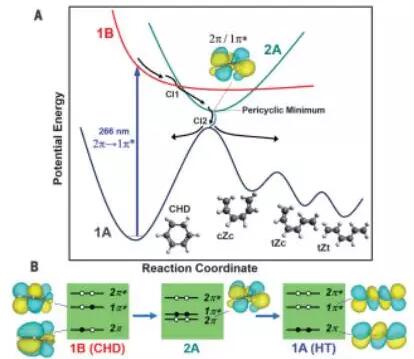
The ultrafast photoactivated electrocyclization ring opening reaction of 1,3-cyclohexadiene is the basic prototype of the photochemical pericyclic reaction. It is generally believed that these reactions are carried out by the intermediate excited state minimum (the so-called peripheral ring minimum), which results in isomerization by non-adiabatic relaxation to the ground state of the photoproduct. Attar et al. directly demonstrated the valence electron structure of the transient intermediate state on a desktop device using a femtosecond (fs) soft X-ray spectrum near the carbon K-edge (~284 eV). In the experiment, the observed nuclear-valence spectral characteristics of the minimum pericyclic ring are combined with the time-dependent density functional theory calculation to reveal the overlap and mixing of the boundary valence orbital energy levels. This transient valence electron structure appears within 60 ± 20 fs after UV excitation and has a decay time constant of 110 ± 60 fs. (Science DOI: 10.1126/science.aaj2198)
3. Two-phase nanostructures to achieve high-strength magnesium alloy
(Dual-phase nanostructuring as a route to highstrength magnesium alloys)
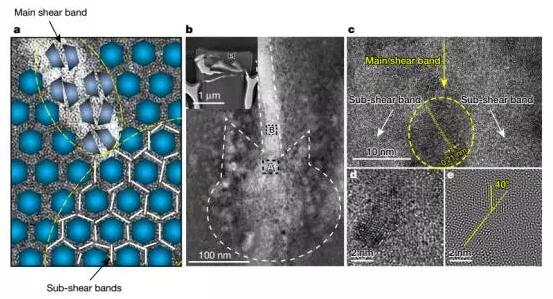
It is very difficult to create materials that can exhibit the theoretical "ideal" strength. Most methods of producing stronger materials are based on controlling defects to prevent the movement of dislocations, but these methods have their limitations. For example, industrial single-phase nanocrystalline alloys and single-phase metallic glasses are strong, but the inverse Hall-Patch effect and shear band formation make them generally softer with relatively low strain (less than 2%). Wu et al. reported a method of combining the strengthening advantages of nanocrystallization with the advantages of amorphization to produce a two-phase material that exhibits near-ideal strength at room temperature without sample size effects. This magnesium alloy system consists of nanocrystalline nuclei embedded in an amorphous vitreous shell, and the resulting dual phase material is nearly as strong as 3.3 gigapascals, which is by far the strongest magnesium alloy film. They also proposed a mechanism supported by a constitutive model in which the crystalline phase (composed of almost dislocation-free grains of about six nanometers in diameter) prevents the propagation of local shear bands during strain; in addition, any shears that occur Within the strip, the embedded grains split and rotate, helping to harden and resist the softening effect of the shear band. (Nature DOI: 10.1038/nature21691)
4. High-performance vitrimers for commercial thermoplastics by dioxane decomposing
(High-performance vitrimers from trademark thermoplastics )
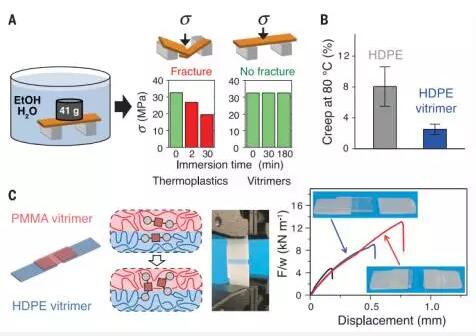
Windmills, automotive and dental restorations require polymer materials and composites that are easy to process, assemble and recycle, and require these materials to have excellent endurance, heat and chemical resistance. Vitrimers, as a polymer network capable of disturbing chemical bonds through exchange reactions, can be prepared if it can be processed from existing plastics at current equipment and high production rates. Röttger et al. reported that the metathesis of dioxaborane has fast and heat resistant properties and that it is used to prepare Vitrimers from different polymers. Although these polymers, such as poly(methyl methacrylate), polystyrene, and high density polyethylene, can be permanently crosslinked, they can be processed by extrusion or injection molding multiple times. These synthetic Vitrimers have excellent chemical resistance and dimensional stability and can be assembled efficiently. This method is applicable to polymers composed of a carbon-carbon single bond skeleton. (Science DOI: 10.1126/science.aah5281)
5. Graphene wrapped sponge quickly cleans up viscous crude oil leakage
(Joule-heated graphene-wrapped sponge ability fast clean-up of viscous crude-oil spill)
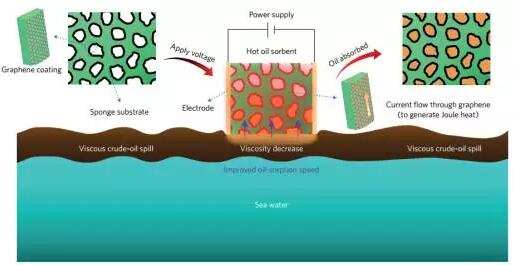
Cleaning up viscous crude oil spills is a global challenge. Although hydrophobic and lipophilic oil absorbing agents have proven to be promising candidates for oil spill recovery. However, the adsorption speed of these viscous crude oil absorbing agents is very limited. Ge et al. reported that Joule-heated graphene-wound sponge (GWS) cleans viscous crude oil at high adsorption rates. The Joule heat of GWS reduces the in-situ viscosity of the crude oil, significantly increasing the oil diffusion coefficient in the GWS pores, thereby accelerating the oil adsorption rate. The oil absorption time was reduced by 94.6% compared to the unheated GWS. Moreover, as the viscosity of the crude oil decreases, the oil recovery rate also increases. The design of this in-situ Joule self-heating adsorbent will promote the practical application of lipophilic, hydrophobic oil adsorbents in the cleansing of viscous crude oil. (Nature Nanotechnology DOI: 10.1038/NNANO.2017.33)
6. Visualization of long-range hot carrier transport in mixed perovskites
(Long-range hot-carrier transport in hybrid perovskites visualized by ultrafast microscopy)
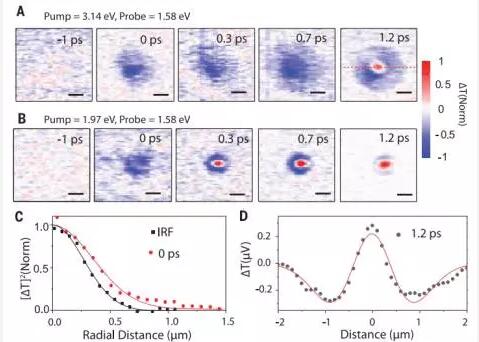
If hot carriers can be captured prior to heating, the Shockley-Queisser limit of solar cell efficiency can be overcome. Recently, carrier cooling times of up to 100 picoseconds have been observed in mixed perovskites, but it is unclear whether these long-lived hot carriers can migrate over long distances for efficient collection. Guo et al. directly observed the hot carrier migration in the methylammonium iodide (CH3NH3PbI3) film by ultra-fast transient absorption microscopy, confirming three different transport modes. They observed that quasi-ballistic transport is associated with excess kinetic energy, resulting in transport distances of up to 230 nanometers, which can overcome grain boundaries. Unbalanced transport lasts for tens of picoseconds, about 600 nanometers, before reaching diffusion transport limits. These results indicate that the hybrid perovskite-based heat carrier device has great potential application value. (Science DOI: 10.1126/science.aam7744)
7. Photochemical hydrogen evolution reaction with quantum yield exceeding 100%
(Multiple exciton generation for photoelectrochemical hydrogen evolution reactions with quantum yields exceeding 100%)
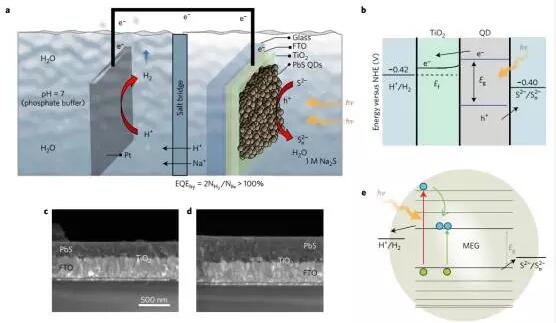
Multiple exciton generation (MEG) in quantum dots (QDs) has the potential to greatly increase power conversion efficiency in solar cell and solar-fuel production. In the MEG process, the absorption of a high-energy photon produces two electron-hole pairs (excitons) that are cooled by phonon emission around the superheat carriers. Yan et al. demonstrated that additional carriers generated by MEG can be used to drive chemical reactions with quantum efficiencies exceeding 100%. They also developed a lead sulfide (PbS) QD photoelectrochemical cell that is capable of driving hydrogen evolution from a Na2S solution with an external quantum efficiency peak exceeding 100%. When the incident photon energy is greater than 2.7 times the bandgap energy, all QD photoelectrodes measured show MEG. The results of this study show a new direction for exploring high-efficiency methods for solar fuels. (Nature Energy DOI: 10.1038/nenergy.2017.52)
8. Quasi-two-dimensional nanosheets produced by inherent growth instability in isotropic materials
(An intrinsic growth instability in isotropic materials leads to quasi-two-dimensional nanoplatelets)
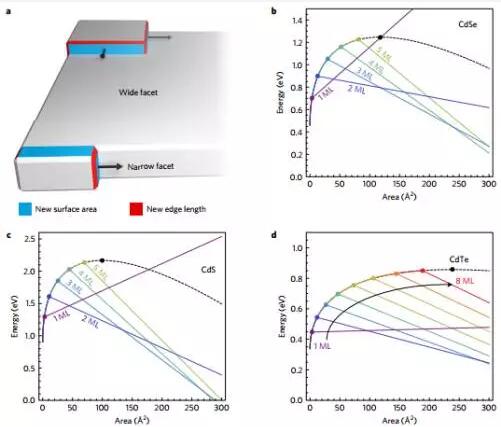
Colloidal nanosheets are atomic-level, quasi-two-dimensional semiconductor wafers that exhibit high-efficiency, pure-spectrum fluorescence. Although researchers are interested in their properties, the mechanisms behind their highly anisotropic shapes and precise atomic-scale thickness are unclear. The mechanism is even counterintuitive with respect to common nanosheets produced by isotropic crystal structures such as sphalerite CdSe and lead halide perovskites. Riedinger et al. have shown that the inherent instability of growth kinetics can lead to such highly anisotropic shapes. By combining the experimental results of CdSe nanosheets with theoretical predictions of enhanced narrow surface section growth, Riedinger et al. developed a model that explained the formation of nanosheets and the observation of time and temperature dependence. Based on the standard concepts of volume, surface and edge energy, the resulting growth instability criteria can be directly applied to other crystalline materials. Therefore, this previously unknown nanoscale shape control mechanism can produce a wider library of quasi-two-dimensional materials. (Nature Materials DOI: 10.1038/NMAT4889)
Polybutyleneadipate-co-terephthalate PBAT
Polybutyleneadipate-Co-Terephthalate Pbat,Thermoplastic Biodegradable Pbat,Flexible Packaging Pbat,Agricultural Film Pbat
Xingbang High Molecular Materials Co., Ltd. , https://www.chemicaladditive.com







